

![]()
LIVESTOCK GUARDIAN DOGS
[This web page and the pages that will eventually follow, are a redesign of the articles "The History of the Shepherd's Dog: Livestock Guardian Dogs" by Carole L. Presberg, that appeared in International Sheepdog News (ISN), the magazine of the International Sheep Dog Society (ISDS), from March/April 2012 to May/June 2014.]
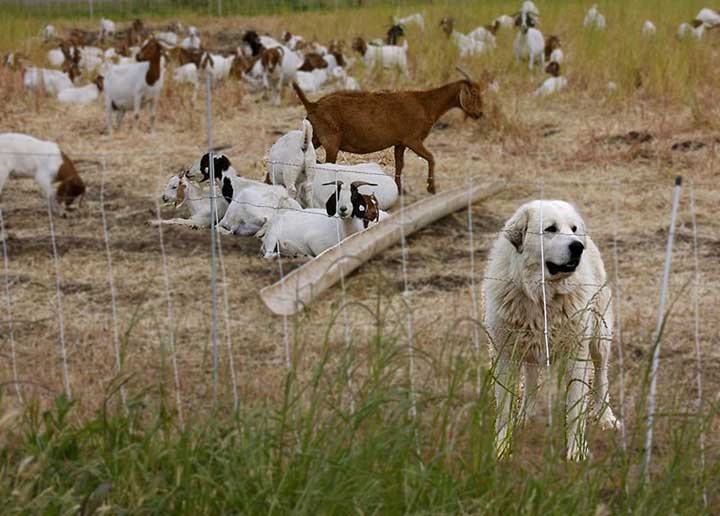
Above, a Great Pyrenees livestock guardian dog and a herd of goats, enclosed behind portablee electrified fencing.
This type of fencing can be moved so that the goats or sheep can graze on small areas at a time and still be enclosed in fencing.
(Photo from Wikipedia by devra and licensed under the Creative Commons Attribution 2.0 Generic license.
Livestock guardian dogs (LGDs) are not herding dogs and they are certainly not collies, but they are shepherds' dogs and some are even used to move the flocks under certain conditions. Therefore, they rightly belong in the history of the shepherd's dog.
We already know most of the terms we will encounter here from other pages, but if you come across one you do not know, please consult our Glossary, which is quite detailed and complete. In an effort to minimize the size of these pages, I will not repeat most of those definitions.
One term I would like to define here, however, is "transhumance". Transhumance is the practice of moving livestock from one grazing ground to another in a seasonal cycle. Transhumance makes the best use of all the land, not only grazing and fertilizing the winter pastures, but removing the flocks to plant crops, giving the crops a chance to grow, and then bringing back the flocks to graze the fields after harvesting them. Transhumance is rooted deeply in human history. In every ancient culture, from the Eurasian Steppe to the Mediterranean basin and beyond, nomadism or transhumance was practiced where there was pastoralism. The difference between nomadism and transhumance is that in nomadism the entire population moves with the herd, taking their homes with them. In Transhumance, only the shepherds accompany the flocks while the rest of the population remains stationary at home, usually engaging in agriculture. A similar pastoral practice is called "transterminance", where flocks are moved shorter distances, grazing among agricultural lands close to the villages during the winter months, and driven to nearby higher pastures in summer. This was the type of pastoralism practiced in the Scottish Highlands prior to the Highland Clearances.
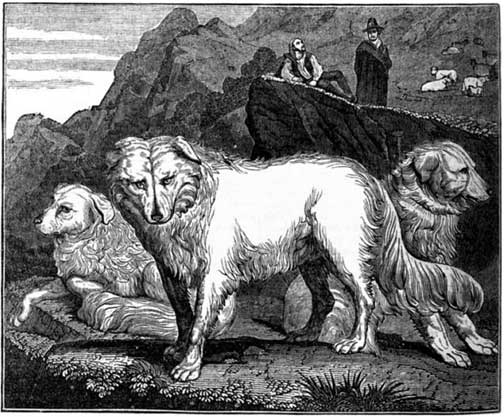 Right, "Wolf dogs of the Abruzzi", from Charles Knight's Penny Magazine of the Society for the Diffusion of Useful Knowledgs, 1833.
Right, "Wolf dogs of the Abruzzi", from Charles Knight's Penny Magazine of the Society for the Diffusion of Useful Knowledgs, 1833.
Guardian dogs are often referred to as "molossers". The word derives from Molossia, a sub-region of ancient Epirus in Greece. The Molossians were renowned for their large dogs used by shepherds to guard their flocks. According to Virgil, the ancient Greeks and Romans also used these dogs for hunting and for protecting the home and in all likelihood, these were the dogs described by Varro that we encountered in the first article in this series. Virgil wrote "never, with them on guard, need you fear for your stalls a midnight thief, or onslaught of wolves, or iberian brigands at your back." These dogs were, and are, substantial dogs of impressive stature, with large heads in proportion to their bodies, loose skin around the neck often described as a "dewlap", short, square muzzles and massive jaws, similar to the Saint Bernard of today. They were known for courage, loyalty, and territoriality, and were therefore favored by the conquering Roman legions as both guardians of the flocks that accompanied them as food on the hoof, and for subjugating the vanquished. Some LGDs today could be categorized as molossers, but certainly not all, although some writers still define them as such.
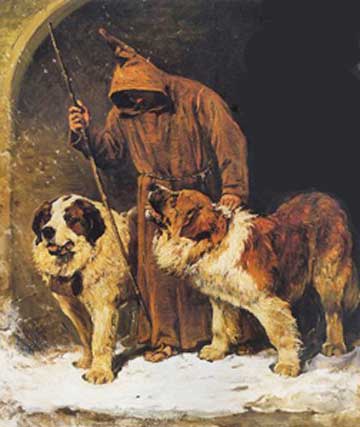 Left, "Saint Bernards to the Rescue" by John Emms (1844-1912)
Left, "Saint Bernards to the Rescue" by John Emms (1844-1912)
Another term frequently used to define LGDs is "mastiff". A mastiff is also a large dog, possibly originating in Asia, and described as having a short, often fawn-colored coat. However, not all mastiffs have short or fawn-colored coats. The Tibetan Mastiff, for example, has a long, usually black coat, and more closely resembles the description of a molosser. Moreover, the word mastiff seems to be frequently used interchangeably with molosser which often leads to confusion. Furthermore, there are numerous mastiff breeds that are not livestock guardians. For instance, the Saint Bernard is often classified as a mastiff. Its archaic name was "Alpine Mastiff" and it was, incidentally, originally a Swiss farm dog, used to protect the herds. Others are watchdogs, dogs of war, fighting dogs, or used for baiting and/or hunting large game. Many of the same dogs are often included in lists of Molossoid breeds and lists of Mastiff-type breeds.
A third term frequently encountered in regard to LGDs is "mountain dog". This is a generic term used to define landrace types from the mountain environs of Central Eurasia. In show circles, large dogs such as the livestock guardians are called (http://en.wikipedia.org/wiki/Giant_dog_breed) "giant dog breeds". Once again, many different breeds other than LGDs fall under this category, and the Saint Bernard comes to mind once again. Some groups define giant breeds as those that weigh more than 100 pounds, but not all LGDs weigh over 100 pounds, though many do. Giant breeds grow rapidly, take longer to mature, often have joint and bone problems, as well as other health issues, and their lifespan is relatively short.
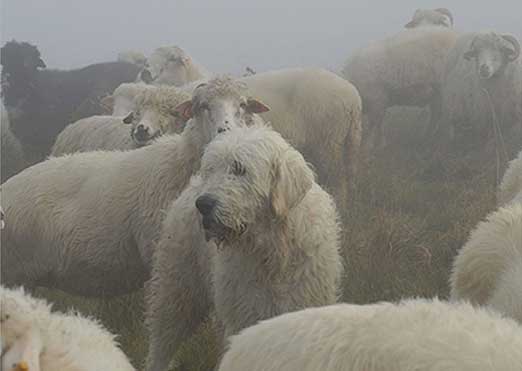 A working South Russian Ovcharka can barely be distinguished from the sheep. (Photo courtesy of Spartan Dogs)
A working South Russian Ovcharka can barely be distinguished from the sheep. (Photo courtesy of Spartan Dogs)
Because of the perplexities surrounding the terms molosser, mastiff, and mountain dog, we will attempt to avoid using them, although in some cases we must. If possible, the dogs discussed here will be referred to simply as livestock guardian dogs or LGDs. Some people prefer the term "livestock protection dog" or LPD, but for our purposes, we will use LGD.
According to Robin Rigg, a zoologist at the University of Aberdeen, "The origins of livestock guarding dogs can be traced back nearly 6000 years, possibly to the upland region of present-day Turkey, Iraq and Syria...Sheep and goats [were] domesticated around 7000-8000 BC in the area of present day Iran and Iraq... The first ancestors of guarding dogs probably arrived in Europe with nomadic shepherds from the Caucasus in the 6th century BC." Others posit origins in Central Asia, Rome, or Tibet. Any and all (or even none) of these scenarios may be true, but only DNA studies may eventually prove where modern LGDs originated. What is certain is that when these dogs arrived in an area, they bred with local dogs to produce the ancestors of today's LGDs.
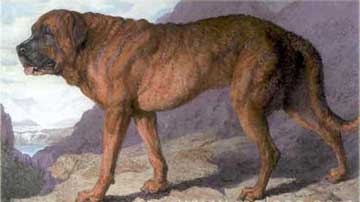 Right, an 1815 painting of an Alpine Mastiff (artist unknown).
Right, an 1815 painting of an Alpine Mastiff (artist unknown).
Rigg says, "These early [sheep and goats] were black, grey or brown and the first guard[ian] dogs were similarly coloured, as is e.g. the Sharplaninatz...White wool was favoured in Roman times and consequently dogs were selected for white colour..." Romans aside, it is thought by some that the reason for LGDs having been selected for white is so the sheep would not fear them and would accept them as part of the flock. Another theory has it that LGDs were bred white to distinguish them from the wolves that preyed upon the flocks. And a fourth theory, put forth by Akbash Dogs International, is that "white dogs were selected in parts of the Fertile Crescent where there was an abundance of water. This is because with surplus water, sheepÕs wool could be dyed with artificial colors. In the dry parts of the Fertile Crescent, sheep were preferred with a variety of colors in the wool. There was not enough water to be able to afford using it for dying wool, so natural color variation was sought. Livestock protection dogs were selected for the same color characteristics of the sheep, so that predators could not easily tell a sheep from a dog." This theory, as fascinating as it is, like all the others, may or may not have actually been the case. Dogs may have simply been selected according to what was available in the often remote areas or, when transhumant pastoralists met, which did happen, possibly frequently, they exchanged ideas and breeding stock.
LGDs are raised with the flock and often spend their entire lives with sheep. Like other dogs, they are social beings and the sheep become their social group. American biologist Raymond Coppinger suggests that LGDs retain juvenile characteristics, including arrested development of predatory behavior, all their lives, which enable them to bond with livestock. He compares them with herding dogs which he says retain their predatory skills.

Above, three Eurasian canid predators, left to right, the Eurasian wolf, the Golden Jackal, and the Dhole (Cuon alpinus or Asiatic wild dog)
Why are livestock dogs necessary? In the countries where they are common, predation is rampant or has been in the past. Wolf predation is most persistent, but other predators include bears, lynx, jackals, eagles, ravens, and hooded crows. In some places there are snow leopards, leopards, and wildcats, and in ancient times some areas even had lions. Roaming packs of feral dogs and bandits also constitute a threat in some regions today. LGDs have been used for millennia in Europe and Asia for flock protection, and today they are used in other parts of the world as well. Unfortunately, with the decline in predator species worldwide, the use of livestock guardian dogs has decreased in many regions. In places where they are actually increasing in use, e.g., North America, Africa, and Australia, advocates point to them as being the "green solution" to predation control, as their presence in flocks tends to ward off predators without seriously affecting endangered wildlife populations. Predators usually flee at the sight of these large, fierce dogs and find easier prey. Traditional methods of predator control have been seen to be less effective. Poison and trapping makes the remaining predator population wary. They learn to avoid traps and poison but continue to pose a risk to livestock. Furthermore, if predators are completely eliminated in an area, others usually move in to take their place.
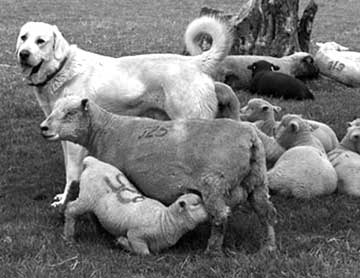 Right, an Akbash with a flock of ewes and lambs. (Photo courtesy of Akbash Dogs International
Right, an Akbash with a flock of ewes and lambs. (Photo courtesy of Akbash Dogs International
Some people think that herding dogs and guardian dogs cannot be used in the same flock, or that LGDs must be removed when sheep are moved by herding dogs. This is not generally true. In many places, both kind of dogs are used in the same flock. Guardian dogs do not normally view herding dogs as predators, and usually leave them alone to do their job. According to Canadian sheep rancher, Arlette Seib, herding dogs must be introduced gradually to LGDs, and must never approach the flock without the presence of the owner. "The more you move the flock with the herding dogs the more the flock guardian dogs become accustomed to it. This does not deter their ability to protect when a real predator arrives on the scene. Unlike humans, whose ability to read animal intentions has become muddled, dogs are expert at reading the intentions and threats of another animal...The LGDs figure out that familiar dogs accompanying the owner are there with permission and they realize that the flock is about to be moved and get ready to come along. Do not assume that because your LGD leaves your stock dog alone, he will leave your friends' dogs alone. The LGD will spot a stranger in their midst in a heartbeat."
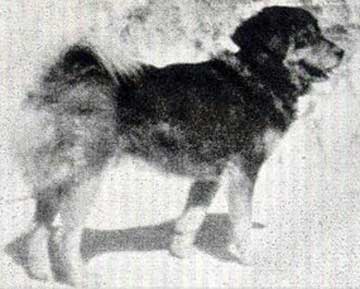 Left, an old photo of a Bangara Mastiff from The Indian Dog by W.V. Soman, 1963. (Courtesy of Himalayan Sheep Dog, A Noble Guardian).
Left, an old photo of a Bangara Mastiff from The Indian Dog by W.V. Soman, 1963. (Courtesy of Himalayan Sheep Dog, A Noble Guardian).
Let us briefly explore the practicality of using LGDs everywhere: would they, for example, be economically and environmentally sound in an island environment such as Britain? Britain has no large predators. The bear became extinct in approximately AD 500, and the wolf was eliminated by the 15th or 16th century, or earlier in some places. According to Johannes Caius, writing in the 16th century "...Our shepherdes dogge is not huge, vaste, and bigge, but of indifferent stature and growth, because it has not to deale with the...wolf, sythence there be none in England." The wolf may have held on a century or two longer in Scotland and Ireland. Today, however, the only predators shepherds have to deal with in Great Britain and Ireland are the red fox and predatory birds like seagulls and eagles. In fact, since rabbits do more damage to agriculture than foxes, and rabbits are the fox's main prey, foxes might even be considered a benefit to agriculture, say some. According to studies presented in 2002, losses due to fox predation were relatively small (under 1%). Furthermore, as these predators are small, they can only really be a threat to newborn or young lambs, or sick sheep, and to poultry.
The economics of predation (cost of housing during lambing and traditional methods of predator control—poison, trapping, hunting with dogs, etc.) would have to be weighed against the cost of utilizing an LGD. If housing and fencing are not feasible, particularly on hill farms, due to cost, it does not appear that LGDs would be any more practical due to economics as well. Even though LGDs will kill small predators and even scare off flying predators, they are costly to maintain. In areas where there is tourism, good fences may make good neighbors, but fencing is expensive; and in Britain, for example, where hill walkers abound, those lovely footpaths that are accessible via stiles and gates would ultimately admit walkers to where LGDs are at work. I have not been able to find any information on whether there are any LGDs in Britain, but Robin Rigg lists the following countries where livestock dogs are being used today: Australia, Bulgaria, Canada, France, India, Israel, Italy, Namibia (in southern Africa), Norway, Poland, Portugal, Romania, Slovakia, Spain, Sweden, Switzerland, Turkey, and the USA. LGDs may also be used in South and Central America, and Mexico, and they are definitely being used in most of Central Europe, Central Asia, and in northwest Asia. Places not listed in Rigg's study are because of lack of data. All the evidence points to the fact that the only LGDs in Britain today are those that are bred as property guards, and for show or as pets.
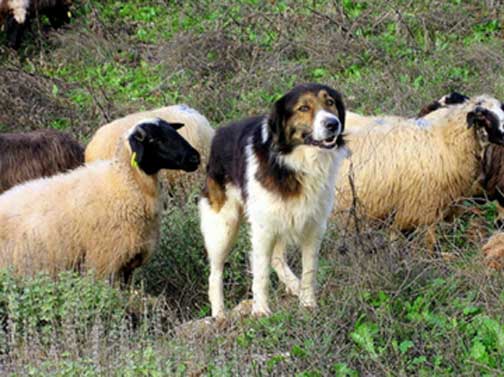 A Greek Shepherd Dog minding its flock. (Photo from Molosserdogs.com)
A Greek Shepherd Dog minding its flock. (Photo from Molosserdogs.com)
Let us examine what makes a good LGD and whether these traits are consistent with being a companion animal. LGDs are large dogs. They generally weigh just under or just over 100 pounds, but some weigh much more. In height they measure between 25 and 30 inches at the shoulder, but a few are a bit smaller, and some are even much larger. LGDs are sexually dimorphic, meaning there is a big difference between males and females, in this case, in size, so that in some LGD breeds only the males grow to over 100 pounds. In many if not most cases both males and females are used successfully as LGDs. LGDs are powerful dogs, imposing-looking, independent and strong willed; calm when no danger threatens but able to act with lightening speed if their charges are threatened. They can be extremely territorial. In some situations, they are called upon to defend against human predators as well as animal predators. These can be thieves, bandits, and even rival shepherds and their dogs in places where resources are scarce. LGDs generally employ posture and barking to discourage their enemies, and only if that fails will they attack. When they attack, however, they are fearless.
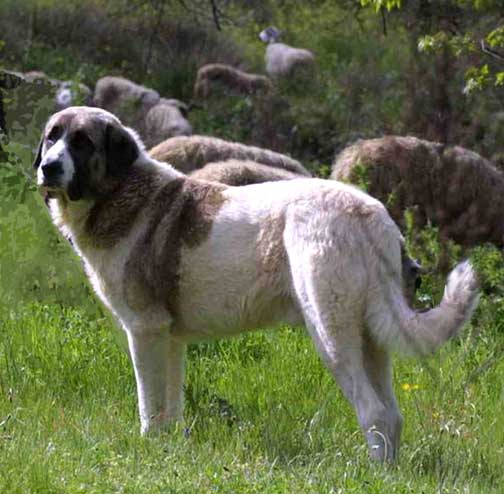 Right, a Portugese Câo de Gado Transmontano stays alert while his sheep graze the woods. (Photo courtesy of Diario Tras-os-Montes)
Right, a Portugese Câo de Gado Transmontano stays alert while his sheep graze the woods. (Photo courtesy of Diario Tras-os-Montes)
LGDs' instincts may make them aggressive to all strangers. As companion dogs, that could mean they are a danger to visitors with or without pets of their own. It might be difficult to walk such a dog on leash among other dogs and people; and training, very necessary under the circumstances, would take an equally strong willed trainer and leader. Still, many LGDs are gentle with children and other family members, and accept people as long as no harm is intended. Guardian tendencies might be bred out or even trained away. Breeding for show, and as pets and property guards may have weakened LGDs livestock protection capabilities. Crossbreeding is another threat. In places where these dogs are used for fighting, hostility towards strangers and all other dogs has prompted breeding separate, less aggressive strains to defend the flocks. Many countries today rely on tourism for a good part of their income, and it would not do to put tourists (and sometimes their pets) in danger from encounters with LGDs. Fencing is sometimes used to prevent confrontation between strangers and LGDs, but often where LGDs are necessary, for example, during transhumance or grazing in steep mountain pastures, fencing is impractical. In countries where transhumance is not the norm, for instance in the USA, fencing is considered essential along with the use of LGDs.
Many of the breeds (but not all) are today recognized by the FCI. The FCI or Fédération Cynologique Internationale is an international association of kennel clubs based in Belgium. It sets physical standards for dog breeds. The United States and Great Britain are not members of this organization, but many European and some Asian countries are, and often the kennel clubs of these countries campaign in favor of recognition for working breeds of dog. Unrest and war have driven many LGDs nearly to extinction. Rescue by the Dog Fancy has often been seen as the only option for breeds on the brink. Kennel clubs see their role as champions and caretakers of these dogs. This may seem laudable, until we realize that with recognition comes standards for appearance at the expense of diversity and possibly the instincts neeeded for livestock guarding.
Diversity assures availability of role-suitable and environment-suitable types of dogs, ensuring that there will be a wide range of working types accessible into the future. If recognition by the FCI is the only way a breed can survive, does it not mean that the breed hasn't survived at all, but that a new breed was created? LGDs have hundreds if not thousands of years of breeding for guarding livestock against predation. That is their heritage and their legacy, and that should not only be respected but protected intact.
Resources:
Coppinger, R., Lorenz J., Glendinning J. and Pinardi P. "Attentiveness of guarding dogs for reducing predation on domestic sheep", Journal of Range Management 36, 1983.
Dohner, Janet Vorwald. Livestock Guardians: Using Dogs, Donkeys and Llamas to Protect Your Herd, Storey Publishing, 2007.
Rigg, Robin. "Livestock guarding dogs: their current use world wide", IUCN/SSC Canid Specialist Group Occasional Paper No 1 [online], Department of Zoology, University of Aberdeen, 2001.
Seib, Arlette. Dog Tale Ranch, "Ranching with Sheep: Flock Guardian and the Herding Dog", http://www.ranching-with-sheep.com/flock-guardian.html
The Fox Website, "Foxes and Agriculture", the Mammal Group, University of Bristol, 2007-2012, http://www.thefoxwebsite.org
White, Dr. Piran. "Fox predation of lambs on hill farms" and "Costs of foxes to agricultural interests in Britain", 2002.
Below, A Kangal dog with a herd of goats in Namibia (Africa) for the Cheetah Conservation Fund.
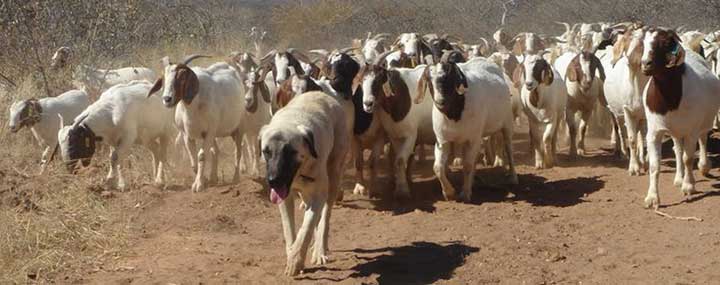
THE OTHER WEB PAGES WE MAINTAIN
These web pages are copyright ©2014
and maintained by webmeistress Carole Presberg
with technical help from webwizard David Presberg
ALL RIGHTS RESERVED
If you are interested in using ANY material on this website, you MUST first ask for permission.